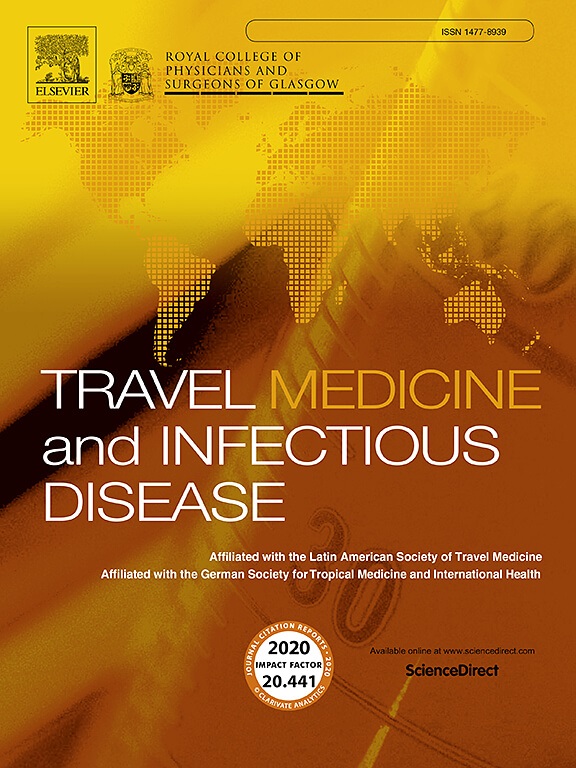Travel-associated carbapenemase-producing Enterobacterales: Epidemiology and risk factors in a Finnish cohort
IF 4.7
3区 医学
Q1 INFECTIOUS DISEASES
引用次数: 0
Abstract
Background
Carbapenemase-producing Enterobacterales (CPE) are increasing worldwide, with strains associated with difficult-to-treat infections. We previously reported that international travel is a major source of CPE acquisition in the Helsinki region, Finland. To clarify the extent of importation, we investigated the epidemiology and associated risk factors of foreign-acquired CPEs.
Methods
We revisited two earlier cohorts. Cohort A (n = 187 after a one-year extension) comprised patients from 2010 through 2024 presumed to have acquired CPE abroad; CPE types were categorized by travel region. Cohort B included 3029 patients screened for CPE from 2010 through 2019 within 12 months after hospitalization abroad. Multivariable analysis identified factors that predispose to colonization.
Results
Among patients hospitalized abroad (Cohort B), CPE rates were particularly high for South Asia (14.6 %) and North Africa (13.7 %). Across the 24 individual countries with data, the highest CPE colonization risks were observed for Egypt (20.8 %) and India (16.4 %). In addition to destination, independent risk factors included antibiotic use, travel type, short interval between discharge from a foreign hospital and screening (within one week or one month) and male sex. For South/Southeast Asia and sub-Saharan Africa, over 70 % of CPE carriers (Cohort A) had metallo-β-lactamase-producing Enterobacterales, predominantly NDM, whereas OXA-48–like enzymes predominated in North Africa and the Middle East.
Conclusions
Hospitalization in high-prevalence countries and antibiotic use emerged as key risk factors for CPE acquisition. Regional variation was evident: OXA-48–like enzymes dominated among CPEs linked to the Middle East and North Africa, whereas NDM was prevalent elsewhere in Eurasia and Africa.
旅行相关的产碳青霉烯酶肠杆菌:芬兰队列的流行病学和危险因素。
背景:产碳青霉烯酶肠杆菌(CPE)在世界范围内正在增加,并与难以治疗的感染有关。我们之前报道过,国际旅行是芬兰赫尔辛基地区CPE获取的主要来源。为了明确输入的程度,我们调查了国外获得性cpe的流行病学和相关危险因素。方法:我们重新访问了两个早期的队列。队列A (n=187,延长一年后)包括2010年至2024年推定在国外获得CPE的患者;CPE类型按旅游地区分类。队列B包括2010年至2019年在国外住院后12个月内接受CPE筛查的3029例患者。多变量分析确定了易发生定植的因素。结果:在国外住院的患者(B组)中,南亚(14.6%)和北非(13.7%)的CPE率特别高。在有数据的24个国家中,埃及(20.8%)和印度(16.4%)的CPE殖民化风险最高。除目的地外,独立风险因素还包括抗生素使用、旅行类型、从国外医院出院到筛查间隔时间短(一周或一个月内)以及男性。在南亚/东南亚和撒哈拉以南非洲,超过70%的CPE携带者(队列A)携带产生金属β-内酰胺酶的肠杆菌,主要是NDM,而oxa -48样酶在北非和中东占主导地位。结论:高流行国家的住院和抗生素使用成为CPE获得的关键危险因素。区域差异很明显:oxa -48样酶在中东和北非相关的cpe中占主导地位,而NDM在欧亚大陆和非洲的其他地方普遍存在。
本文章由计算机程序翻译,如有差异,请以英文原文为准。
求助全文
约1分钟内获得全文
求助全文
来源期刊

Travel Medicine and Infectious Disease
PUBLIC, ENVIRONMENTAL & OCCUPATIONAL HEALTH-INFECTIOUS DISEASES
CiteScore
19.40
自引率
1.70%
发文量
211
审稿时长
49 days
期刊介绍:
Travel Medicine and Infectious Disease
Publication Scope:
Publishes original papers, reviews, and consensus papers
Primary theme: infectious disease in the context of travel medicine
Focus Areas:
Epidemiology and surveillance of travel-related illness
Prevention and treatment of travel-associated infections
Malaria prevention and treatment
Travellers' diarrhoea
Infections associated with mass gatherings
Migration-related infections
Vaccines and vaccine-preventable disease
Global policy/regulations for disease prevention and control
Practical clinical issues for travel and tropical medicine practitioners
Coverage:
Addresses areas of controversy and debate in travel medicine
Aims to inform guidelines and policy pertinent to travel medicine and the prevention of infectious disease
Publication Features:
Offers a fast peer-review process
Provides early online publication of accepted manuscripts
Aims to publish cutting-edge papers
 求助内容:
求助内容: 应助结果提醒方式:
应助结果提醒方式:


